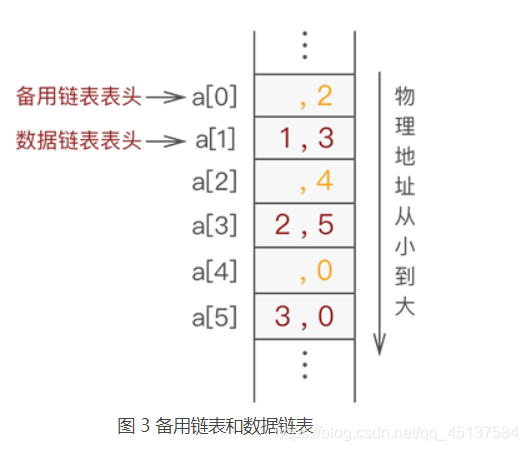1.静态链表产生的原因?
因为顺序存储结构和链式存储结构两者都有各自的优点,如下表所示。
| 性能 | 具体功能 | 顺序存储 | 链式存储 |
|---|---|---|---|
| 空间性能 | 存储分配 | 一次性分配 | 动态分配(优) |
| 空间性能 | 存储密度 (下面会有解释) | =1(优) | <1 |
| 时间性能 | 查找 | O(n/2) | O(n/2) |
| 时间性能 | 读运算 | O(1)(优) | O((n+1)/2) 最好情况为1,最坏情况为n |
| 时间性能 | 插入运算 (性能主要指 需要移动元素个数) | O(n/2)最好 最好情况为0,最坏情况为n | O(1),更优 |
| 时间性能 | 删除运算 | O((n-1)/2) 最好情况为0,最坏情况为n-1 | O(1),更优 |
所以我们需要产生一种存储结构,可以融合顺序表和链表的优点,从而达到快速访问元素,又能快速增加或删除数据元素,所以产生了静态链表。
2.静态链表
静态链表:也是线性存储结构的一种,它兼顾了顺序表和链表的优点。
特点:
1.一次性分配所以内存。
2.数据全部存储在数组中,且存储位置是随机的。
3.数据之间的"一对一“的逻辑关系通过一个整形变量”游标"维持。
存储结构如图所示:

结构体类型:
typedef struct LNode{
int data;//数据域:用来存储数据。
int next;//游标:用来找到后继元素所在数组中的位置。
}LNode;
4.备用链表
静态链表中,除了数据本身通过游标组成的链表外,还需要有一条连接各个空闲位置的链表,称为备用链表。

备用链表的作用:可以清楚地知道数组中是否有空闲位置,以便添加数据时使用。
当静态链表中数组下标为 0 的位置上存有数据,则证明数组已满。
3.创建静态链表
#include <bits/stdc++.h>
using namespace std;
#define maxSize 100
typedef struct LNode{
int data;
int next;
}LNode;
//创建备用链表
void reserveArr(LNode *array){
for(int i=0;i<maxSize;i++){
array[i].next=i+1;
array[i].data=-1;
}
array[maxSize-1].next=0;
}
//提取分配空间
int mallocArr(LNode *array){
int i=array[0].next;
if(array[0].next){
array[0].next=array[i].next;
}
return i;
}
//创建静态链表
int initArr(LNode *array){
reserveArr(array);
int body=mallocArr(array);
int tempBody=body;
int length;
cin>>length;
for(int i=1;i<length+1;i++){
int j=mallocArr(array);
array[tempBody].next=j;
int temp;
cin>>temp;
array[j].data=temp;
tempBody=j;
}
array[tempBody].next=0;
return body;
}
//遍历输入
void dispalyArr(LNode *array,int body){
int tempBody=body+1;
while(array[tempBody].next){
cout<<array[tempBody].data<<" ";
tempBody=array[tempBody].next;
}
cout<<array[tempBody].data<<" ";
}
int main(){
LNode array[maxSize];
int body=initArr(array);
dispalyArr(array,body);
return 0;
}
结果:

4.添加数据
//插入数据
void insertArr(LNode * array,int body,int add,char a){
int tempBody=body;//tempBody做遍历结构体数组使用
//找到要插入位置的上一个结点在数组中的位置
for (int i=1; i<add; i++) {
tempBody=array[tempBody].next;
}
int insert=mallocArr(array);//申请空间,准备插入
array[insert].data=a;
array[insert].next=array[tempBody].next;//新插入结点的游标等于其直接前驱结点的游标
array[tempBody].next=insert;//直接前驱结点的游标等于新插入结点所在数组中的下标
}
整体代码:
#include <bits/stdc++.h>
using namespace std;
#define maxSize 100
typedef struct LNode{
int data;
int next;
}LNode;
//创建备用链表
void reserveArr(LNode *array){
for(int i=0;i<maxSize;i++){
array[i].next=i+1;
array[i].data=-1;
}
array[maxSize-1].next=0;
}
//提取分配空间
int mallocArr(LNode *array){
int i=array[0].next;
if(array[0].next){
array[0].next=array[i].next;
}
return i;
}
//创建静态链表
int initArr(LNode *array){
reserveArr(array);
int body=mallocArr(array);
int tempBody=body;
int length;
cin>>length;
for(int i=1;i<length+1;i++){
int j=mallocArr(array);
array[tempBody].next=j;
int temp;
cin>>temp;
array[j].data=temp;
tempBody=j;
}
array[tempBody].next=0;
return body;
}
//插入数据
void insertArr(LNode * array,int body,int add,char a){
int tempBody=body;
for (int i=1; i<add; i++) {
tempBody=array[tempBody].next;
}
int insert=mallocArr(array);
array[insert].data=a;
array[insert].next=array[tempBody].next;
array[tempBody].next=insert;
}
//遍历输入
void dispalyArr(LNode *array,int body){
int tempBody=body+1;
while(array[tempBody].next){
cout<<array[tempBody].data<<" ";
tempBody=array[tempBody].next;
}
cout<<array[tempBody].data<<" ";
}
int main(){
LNode array[maxSize];
int body=initArr(array);
dispalyArr(array,body);
cout<<endl;
insertArr(array,body,2,10);
dispalyArr(array,body);
return 0;
}
结果:

5.删除操作
//备用链表回收空间的函数,其中array为存储数据的数组,k表示未使用节点所在数组的下标
void freeArr(LNode * array,int k){
array[k].next=array[0].next;
array[0].next=k;
}
//删除结点函数,a 表示被删除结点中数据域存放的数据
void deletArr(LNode * array,int body,char a){
int tempBody=body;
//找到被删除结点的位置
while (array[tempBody].data!=a) {
tempBody=array[tempBody].next;
//当tempBody为0时,表示链表遍历结束,说明链表中没有存储该数据的结点
if (tempBody==0) {
printf("链表中没有此数据");
return;
}
}
//运行到此,证明有该结点
int del=tempBody;
tempBody=body;
//找到该结点的上一个结点,做删除操作
while (array[tempBody].next!=del) {
tempBody=array[tempBody].next;
}
//将被删除结点的游标直接给被删除结点的上一个结点
array[tempBody].next=array[del].next;
//回收被摘除节点的空间
freeArr(array, del);
}
//插入数据
void insertArr(LNode * array,int body,int add,char a){
int tempBody=body;//tempBody做遍历结构体数组使用
//找到要插入位置的上一个结点在数组中的位置
for (int i=1; i<add; i++) {
tempBody=array[tempBody].next;
}
int insert=mallocArr(array);//申请空间,准备插入
array[insert].data=a;
array[insert].next=array[tempBody].next;//新插入结点的游标等于其直接前驱结点的游标
array[tempBody].next=insert;//直接前驱结点的游标等于新插入结点所在数组中的下标
}
//总共代码
#include <bits/stdc++.h>
using namespace std;
#define maxSize 100
typedef struct LNode{
int data;
int next;
}LNode;
//创建备用链表
void reserveArr(LNode *array){
for(int i=0;i<maxSize;i++){
array[i].next=i+1;
array[i].data=-1;
}
array[maxSize-1].next=0;
}
//提取分配空间
int mallocArr(LNode *array){
int i=array[0].next;
if(array[0].next){
array[0].next=array[i].next;
}
return i;
}
//创建静态链表
int initArr(LNode *array){
reserveArr(array);
int body=mallocArr(array);
int tempBody=body;
int length;
cin>>length;
for(int i=1;i<length+1;i++){
int j=mallocArr(array);
array[tempBody].next=j;
int temp;
cin>>temp;
array[j].data=temp;
tempBody=j;
}
array[tempBody].next=0;
return body;
}
//备用链表回收空间的函数,其中array为存储数据的数组,k表示未使用节点所在数组的下标
void freeArr(LNode * array,int k){
array[k].next=array[0].next;
array[0].next=k;
}
//删除结点函数,a 表示被删除结点中数据域存放的数据
void deletArr(LNode * array,int body,char a){
int tempBody=body;
//找到被删除结点的位置
while (array[tempBody].data!=a) {
tempBody=array[tempBody].next;
//当tempBody为0时,表示链表遍历结束,说明链表中没有存储该数据的结点
if (tempBody==0) {
printf("链表中没有此数据");
return;
}
}
//运行到此,证明有该结点
int del=tempBody;
tempBody=body;
//找到该结点的上一个结点,做删除操作
while (array[tempBody].next!=del) {
tempBody=array[tempBody].next;
}
//将被删除结点的游标直接给被删除结点的上一个结点
array[tempBody].next=array[del].next;
//回收被摘除节点的空间
freeArr(array, del);
}
//插入数据
void insertArr(LNode * array,int body,int add,char a){
int tempBody=body;//tempBody做遍历结构体数组使用
//找到要插入位置的上一个结点在数组中的位置
for (int i=1; i<add; i++) {
tempBody=array[tempBody].next;
}
int insert=mallocArr(array);//申请空间,准备插入
array[insert].data=a;
array[insert].next=array[tempBody].next;//新插入结点的游标等于其直接前驱结点的游标
array[tempBody].next=insert;//直接前驱结点的游标等于新插入结点所在数组中的下标
}
//遍历输入
void dispalyArr(LNode *array,int body){
int tempBody=body+1;
while(array[tempBody].next){
cout<<array[tempBody].data<<" ";
tempBody=array[tempBody].next;
}
cout<<array[tempBody].data<<" ";
}
int main(){
LNode array[maxSize];
int body=initArr(array);
dispalyArr(array,body);
cout<<endl;
insertArr(array,body,2,10);
dispalyArr(array,body);
cout<<endl;
deletArr(array,body,10);
dispalyArr(array,body);
return 0;
}

6.查询数据
//插入数据
void insertArr(LNode * array,int body,int add,char a){
int tempBody=body;//tempBody做遍历结构体数组使用
//找到要插入位置的上一个结点在数组中的位置
for (int i=1; i<add; i++) {
tempBody=array[tempBody].next;
}
int insert=mallocArr(array);//申请空间,准备插入
array[insert].data=a;
array[insert].next=array[tempBody].next;//新插入结点的游标等于其直接前驱结点的游标
array[tempBody].next=insert;//直接前驱结点的游标等于新插入结点所在数组中的下标
}

学习参考博客地址:http://c.biancheng.net/view/3340.html





















 520
520











 被折叠的 条评论
为什么被折叠?
被折叠的 条评论
为什么被折叠?








